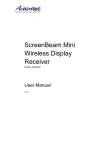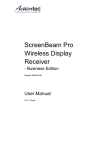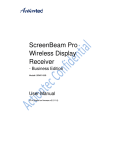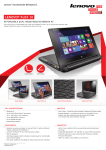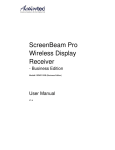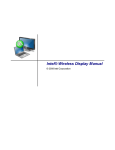Download sb pro user um
Transcript
Wireless Display Receiver ScreenBeam Pro Receiver Model # SBWD100B User Guide rev. 2.1 Table of Contents Introduction 4 Package Contents 4 Getting to Know the Receiver 5 System Requirements 6 Installing the Receiver 7 Connecting to an HDTV 7 Setting Up for the First Time Connecting via Windows 8.1 9 9 Connecting via Intel WiDi 13 Connecting via Miracast™ 18 Tips for Optimal Performance 19 Display and Control Options 20 Display Mode 20 Ultra-Low Delay 22 2 ScreenBeam Pro Receiver USB over Network 23 Restore Default Settings 24 Troubleshooting and FAQs 25 Troubleshooting 25 Frequently Asked Questions 30 Specifications 40 General 40 Wireless 41 Electrical 41 Environmental 42 Notices 43 Warranty 43 GPL Info 43 EU CE Declaration of Conformity 44 Technical Support 44 3 Introduction Thank you for your purchase of Actiontec’s ScreenBeam Pro Wireless Display Receiver. The Receiver wirelessly streams what’s on a Intel WiDi or Miracast™compatible device to an HDTV, including movies, videos, photos, music, and more. The Receiver’s features include fast setup, smooth video playback, full 1080p HD support, ultra-low delay, Windows 8.1 optimization, versatile compatibility, low power consumption, and more. This user manual explains the procedures needed to install, connect to, operate, configure, and upgrade the Receiver, and also describes a few different possible scenarios about locating faults. Package Contents • ScreenBeam Pro Wireless Display Receiver (1) • HDMI cable (1) • AC power adapter (1) • Quick Start Guide (1) 4 ScreenBeam Pro Receiver Getting to Know the Receiver ! Power Light Indicates power supply status. USB Port Used for software upgrades via a USB flash drive or for USB over network application (UoIP). Reset Button Used to reset the Receiver to default settings. 5 Introduction Video Out (HDMI) Used to connect HDMI cable to HDTV/projector for video and audio output. Power Input (5V DC) Used to connect to power cable. System Requirements Receiver To connect the Receiver, the following must be available: • A display device with one free HDMI port (type A) • An available power outlet Compatible Devices The Receiver is compatible with the following devices: • 4th Gen Ultrabook with Intel WiDi 4.0 or higher • Laptop or notebook with Intel WiDi 3.5 or higher • Smartphone, tablet, or laptop running Windows 8.1 • Wi-Fi Miracast™-certified smartphones and tablets • Non-WiDi/Miracast-ready computers with Actiontec USB Transmitter (Windows 7 or higher) 6 Installing the Receiver This chapter explains how to connect the Receiver to an HDTV. Make sure all the contents from the Receiver’s package are available before starting. Connecting to an HDTV To connect the Receiver to an HDTV: 1. Get the Receiver, AC power adapter, and HDMI cable from the Receiver’s package. 2. Plug one end of the supplied HDMI cable into the HDMI port (Video Out) on the Receiver, and the other end into an available HDMI port on the HDTV. 3. Plug the connector of the power cord to the Receiver’s power input port labeled "5V DC", and plug the power adapter to a power outlet. When Steps 1, 2, and 3 are complete, the hardware should be connected as shown in the figure below: ! 7 ScreenBeam Pro Receiver 4. Turn on the HDTV and set it to display the input from the correct HDMI port (the one you have the Receiver plugged into in Step 2). 5. Verify the Ready To Connect screen appears on the HDTV. ! The Receiver is connected to the HDTV, and is ready for use. Note: Connections to other display devices are similar. ! 8 Setting Up for the First Time This chapter explains how to connect the Receiver for the first time to the source device. There are three source device options: Windows 8.1, Intel WiDi, and Miracast™. Connecting via Windows 8.1 This section explains how to connect a device running Windows 8.1 to the Receiver. 1. From the Windows desktop, go to the Charms menu and select Devices. You can also use the shortcut keys, Windows logo + K. ! ! 9 ScreenBeam Pro Receiver 2. From the Devices screen, select Project. ! 3. From the Project screen, select Add a wireless display. ! Note: If the device is running Windows 8.1 and the screens above do not appear, go to: http://www.actiontec.com/widi81 ! for the latest software update. Alternatively, update the Windows 8.1 device via the Windows Update application. 10 Setting Up for the First Time 4. Select the Receiver from the Select a Device list. ! 5. A Connecting… screen appears. ! ! Note: A PIN code may be required to connect to the Receiver. 11 ScreenBeam Pro Receiver 6. The HDTV displays messages to show the status of the connection. ! ! 7. The device connects to the Receiver, and the device’s screen is displayed on the HDTV. ! 12 Setting Up for the First Time Connecting via Intel WiDi This section explains how to connect a device running Intel's WiDi application to the Receiver. Follow the procedure below to connect the device to the Receiver: 1. Launch the Intel Wireless Display Application on the device. To find the application, go to Windows Search on the device and search for “Intel WiDi.” 2. The Intel WiDi application scans for available Receivers automatically. Select the Receiver and click Connect. (Clicking in the Connect Automatically checkbox is optional.) ! ! Note: If the Receiver is not found, click Scan to scan again. 13 ScreenBeam Pro Receiver 3. Wait until the Receiver displays a PIN on the HDTV, and a PIN entry box is displayed on the screen of the WiDi device. Enter the PIN in the PIN entry box on the WiDi device, then click Continue. ! ! ! 14 Setting Up for the First Time 4. The HDTV displays messages to show the status of the connection. ! ! ! 15 ScreenBeam Pro Receiver 5. A Connection Successful screen appears on the device's screen. Click Finished, and the device’s screen is displayed on the HDTV. ! Adjusting the HDTV Picture If edges of the device screen cannot be seen on the HDTV or black edges are visible, adjust the cropping settings: 1. Go to the Intel WiDi application and click Settings. The Settings screen appears. ! ! 16 Setting Up for the First Time 2. Click Picture and Sound. In the Settings - Picture and Sound screen, select Adjust cropping. ! 3. Adjust the HDTV picture by clicking “+” (plus) or “-” (minus). ! ! 17 ScreenBeam Pro Receiver WiDi Software Version Support Make sure the device supports Intel Wireless Display (WiDi) software version 3.5 or higher. To find out which version of Intel WiDi the device is running, launch the Intel WiDi application and click Help, then navigate to the About Intel® WiDi section. To obtain the latest Intel WiDi software and drivers, go to: http://www.intel.com/go/wirelessdisplayupdate or click Check Intel® WiDi website for updates. ! Connecting via Miracast™ This section explains how to connect a Miracast™-enabled Android device, such as a smartphone, a tablet, or a game console, to the Receiver. For the best performance, the Miracast™ device should be running the latest software. 1. On a Miracast™-enabled Android device, locate and open the Wireless Display application (check for the application under Settings). Note: The name of the Wireless Display Application depends on the device type and model. Refer to the device's user manual for more details. 18 Setting Up for the First Time 2. The Wireless Display Application scans for available devices. Select the Receiver from the device list. Entering a PIN code may be required, which will be displayed on the HDTV screen. 3. Wait for the device to pair with the Receiver. When it does, the device's screen will be displayed on the HDTV. Tips for Optimal Performance For optimal performance, try the following: Keep the Receiver within line-of-sight of the source device, which helps ensure the Receiver receives the best possible signal. The Receiver's optimal wireless range is within 30 feet from the source device. However, actual range and effectiveness depends on many factors, including nearby sources of interference and the building materials used in the surrounding structure. Avoid placing the Receiver near wireless interference sources, such as electric fans, items with motors, microwave ovens, or cordless phones. 19 Display and Control Options This chapter describes the display modes and control options supported by the Receiver. Display Mode The Receiver supports three display modes when connected with a compatible wireless display application (Intel WiDi or Windows 8.1 Project, for example). In Windows, press the Windows logo + P keys simultaneously ( + P) to launch the display options and select the desired display mode from the options. ! 20 ScreenBeam Pro Receiver ! Duplicate Duplicate mode is used to display the same content on both the device's screen and the HDTV simultaneously. Note: There may be minor delay between the content displayed on the HDTV screen compared to the device’s screen. This is due to the current state of wireless display technology. Extend Extend mode creates a single, extended screen between the source device and the HDTV. When in the Extend mode, dragging windows to the right side of the device's screen displays those windows on the HDTV, while dragging windows to the left of the HDTV screen displays them back on the device's screen. This mode allows users to display selected content on the HDTV, while all other windows remain on the device's screen. When this mode is first selected, the HDTV displays only the Windows desktop. Second Screen Only Second Screen Only mode causes the HDTV to be the only display for the device. Everything will be displayed on the connected screen, and the device’s screen will be blank. 21 Display and Control Options Ultra-Low Delay The Receiver also supports Ultra-Low Delay, which helps reduce end-toend wireless display latency. Real-time applications, such as games, can run without noticeable delay when the Ultra-Low Delay mode is enabled on supported devices. Intel WiDi Ultra-Low Delay can be activated on a device running Intel WiDi 3.5 or higher. To switch to Ultra-Low Delay mode: 1. Launch the Intel WiDi application, connect to the Receiver, then click Settings. ! 2. From the Settings screen, select Current Display Settings. ! 22 ScreenBeam Pro Receiver 3. Select Prioritize Speed in the Quality vs. Speed section of the screen, then click Apply Settings. Refer to Intel's support documentation for more information. ! USB over Network The Receiver’s USB over Network (UoIP) feature allows the use of USB HID peripheral devices, either from the source device or from the USB device side. To connect a USB keyboard, mouse, or trackpad: 1. Use the ScreenBeam Configuration Utility to set the USB Local Access to On, and then select UoIP or UIBC. Refer to Setting up USB Local Access for details. 2. Plug the USB device into the Receiver’s USB port and wait for the device to be detected. This may take 10-15 seconds. 3. Use the USB device (keyboard, mouse, or trackpad) to control the source device. Note: UoIP is compatible with Intel WiDi only. ! 23 Display and Control Options Restore Default Settings To restore the Receiver's default factory settings: 1. Power on the Receiver, and wait until the Ready to Connect screen appears. 2. Hold down the Receiver's Reset button. 3. When the Resetting to Factory Defaults screen appears on the HDTV, release the Reset button. The Receiver reboots. Once this is complete, the Receiver will be running with its default settings. 24 Troubleshooting and FAQs This chapter describes some problems you may encounter using the Receiver, and possible solutions to those problems. Also included are frequently asked questions (FAQs), and answers to those questions. Troubleshooting I'm not seeing anything on my HDTV screen after powering on the Receiver. Check the cable connections and make sure the TV Input setting is the same as the HDMI port to which the Receiver is connected. After upgrading from Windows 8 to Windows 8.1, I can no longer connect to the Receiver, or I'm having problems with my connection. Make sure you've followed Intel's instructions after the upgrade. Refer to Intel's WiDi website (http://www.actiontec.com/widi81) for more information. Intel WiDi does not work after upgrading to Windows 8.1 and I can't connect to ScreenBeam Pro. Windows 8.1 provides the native Miracast feature. Previous Intel WiDi systems upgraded to Windows 8.1 must use the Project feature. To connect with ScreenBeam Pro Receiver: go to Charms > Devices > Project > Add a wireless display > Connect to ScreenBeam Pro Receiver. 25 ScreenBeam Pro Receiver In some instances, I can't connect to the Receiver from WiDi after installing antivirus software. To solve this problem, add Intel WiDi to the antivirus-approved whitelist of applications, and then reconnect. I'm seeing artifacts and experiencing a choppy, juddering video stream. In noisy Wi-Fi environments, audio and video freezes may be observed while playing video content, and longer than expected latency may occur when streaming. To ensure you have an optimal Wi-Fi environment: If your Receiver is directly plugged into the HDMI port on the back of your HDTV, reconnect the Receiver to the HDTV with the HDMI extension cable provided and place the Receiver in front of your HDTV and in direct line of sight with your device. Disconnect and reconnect the Receiver. If the source device is connected to a wireless router, restart the router, or change the wireless channel on your wireless router/AP. Refer to the wireless router’s user manual for more information. I'm seeing choppiness and brief pauses while watching Internet video on my Miracast™ device. Wireless interference may cause Internet video playback to be choppy. If this occurs, try the following: Disconnect the device from the Receiver. Make sure the Internet connection is good and that the video playing on the phone is smooth. Clear the YouTube cache and try playing the video again. ! 26 Troubleshooting I'm seeing choppiness and brief pauses while watching local video on my Miracast™ device. Wireless interference may cause the video playback to be choppy. If this occurs, try the following: Make sure you are in the same room as the Receiver is. Set the media player to use the H/W decoder, if available. Reboot the Miracast™ device and Receiver and connect again. Avoid moving the Miracast™ device around too much. Change the wireless channel on your wireless router/access point. NVIDIA Shield does not see the Receiver or may see the Receiver as “unavailable” or “busy” even after a rescan. Exit out of the NVIDIA's Miracast settings window and go back. My Windows 8.1 displays to the TV but the four edges are cut off (overscan). This is expected with some system’s supported display resolution. You can adjust Windows screen resolution settings to fit the PC's screen on your TV display. When I connect to an access point or wireless router with an active WiDi session, the WiDi connection drops. This is a known issue with Intel WiDi. It happens with either 3.5.41.0 or 4.0.1.8 on both Windows 7 and 8. Re-connect the WiDi session or connect to the AP first before starting a WiDi session. ! 27 ScreenBeam Pro Receiver I encounter connection failure with the Receiver and my device can’t connect to it any more. • Reboot the Receiver and try connection again. Or, reboot your device (laptop/Ultrabook/tablet/smartphone) and try connection again. • Reboot both the Receiver and your device and try connection again. • If you are using a Windows 8.1 operating system, go to Change PC settings > PC and Devices > Devices > Projectors, remove the profile of ScreenBeam Pro from your device (PC/laptop/Ultrabook), and try connection again. • If you are using an Android operating system, go to WLAN > WiFi Direct > Remembered Groups, remove the profile of ScreenBeam Pro from your device, and try connection again. I can’t connect to the Receiver with ScreenBeam Configuration Utility on my device. The Utility can’t find the Receiver. In Windows 8.1, you must connect your device to the Receiver at least one time. In doing so, the profile of the Receiver is saved to your device. Then the Utility on your device can connect to the Receiver. In Windows 7/8, you must connect your device to the Receiver with Intel WiDi first, and then the Utility on your device can connect to the Receiver. In Windows 8.1, I can’t adjust the screen size with the ScreenBeam Configuration Utility. I can’t find the screen size adjustment option. The screen size adjustment option is not available if your device doesn’t connect to the receiver. You must connect your device to the Receiver first, and then launch the Utility and configure the receiver. ! 28 Troubleshooting When I connect the source device to a wireless network (router/ AP), why does the Receiver disconnect automatically? The source device’s communication channel changes when you connect your device to a wireless network (router/AP) when the source device is connected to the Receiver. As a result, the Receiver disconnects from the source device. Try connecting your device to the wireless network before connecting it to ScreenBeam Pro. In this way, the Receiver works on the same channel with the source device and the wireless network, and no connection interruption will occur. My device is running the Windows 8.1 operating system. But the Add a wireless display menu is not available in Charms > Devices > Project. What should I do? If you are running Windows 8.1 and Add a wireless display does not appear, try the following: • For Intel WiDi compatible devices, go to http://www.actiontec.com/widi81 for the latest software update. • Update your Windows 8.1 via the Windows Update application. • Consult your device manufacturer, and update the WLAN adapter and display adapter of your device to the latest drivers. ! 29 ScreenBeam Pro Receiver Frequently Asked Questions Can my device connect to the Receiver? To connect to the Receiver, your device must be Intel WiDi compatible or Wi-Fi Miracast-capable. For a system to support Intel WiDi 3.5 (or later), it should have most, if not all, of the required Intel chipsets (processor, graphic card, and wireless chipset). The following are some guidelines on the types of computer system that can support Intel WiDi: • If your system is an Ultrabook (4th Gen Intel Core processor), it most likely supports and has Intel WiDi 4.x preinstalled. • If your system is an Ultrabook (3rd Gen Intel Core processor or older), it should have the required chipsets to support Intel WiDi. Update your drivers and download the Intel WiDi software at: http:// www.intel.com/go/wirelessdisplayupdate • If your system is a laptop or a notebook, it may support Intel WiDi if it meets the following processor, graphics, and wireless chipset requirements: Processor One of the following processors is required: ! 2nd generation Intel Core i3/i5/i7 Mobile Processor ! 3rd Generation Intel Core i3/i5/i7 Mobile and Desktop Processor ! 4th Generation Intel Core i3/i5/i7 Mobile and Desktop Processor ! Intel Pentium N3510 Processor ! Intel Celeron N2805 Processor ! Intel Celeron N2810 Processor ! Intel Celeron N2910 Processor ! Intel Atom Z3740 Processor 30 Troubleshooting ! Intel Atom Z3740D Processor ! Intel Atom Z3770 Processor ! Intel Atom Z3770D Processor Graphics One of the following graphics solutions is required: ! Intel Iris Pro Graphics 5200 ! Intel Iris Graphics 5100 ! Intel HD Graphics 5000 ! Intel HD Graphics 4600 ! Intel HD Graphics 4400 ! Intel HD Graphics 4200 ! Intel HD Graphics 4000 ! Intel HD Graphics 3000 (mobile) ! Intel HD Graphics 2500 ! Intel HD Graphics 2000 (mobile) Wireless Adapter One of the following wireless adapters is required: ! Intel Centrino Wireless-N 1000, 1030, 2200, or 2230 ! Intel Centrino Wireless-N 2200 for Desktop ! Intel Centrino Advanced-N 6200, 6205, 6230, or 6235 ! Intel Centrino Advanced-N 6205 for Desktop ! Intel Centrino Wireless-N + WiMAX 6150 ! Intel Centrino Advanced-N + WiMAX 6250 ! Intel Centrino Ultimate-N 6300 ! Intel Dual Band Wireless-N 7260 ! Intel Dual Band Wireless-AC 7260 31 ScreenBeam Pro Receiver ! Intel Dual Band Wireless-AC 7260 for Desktop ! Intel Dual Band Wireless-AC 3160 ! Intel Wireless-N 7260 ! Broadcom BCM43228 ! Broadcom BCM43241 ! Broadcom BCM4352 Operating System One of the following operating systems is required: ! Microsoft Windows 7 ! Microsoft Windows 8 ! Microsoft Windows 8.1 System Requirements for Wi-Fi Miracast™ ! Android 4.2 ! Windows 8.1 The Receiver is not compatible with Apple devices. How can I tell if my device supports Wi-Fi Miracast? Look for one of the following Miracast applications on your device. Only some application names are listed below. Note that different manufacturers may have different names for Miracast apps on their products. • Wireless display • Wireless mirroring • Screen mirroring • AllShareCast (Samsung devices only) • Cast screen 32 Troubleshooting Visit ScreenBeam Pro compatibility page for the recommended Miracast devices. Do I need to install drivers/apps to use the ScreenBeam Pro Receiver? • For Windows 7/8, you may need to install the Intel WiDi (3.5 or higher) application. • For Windows 8.1, you only need to install the latest Windows updates. • For Android 4.2 or higher, no app is required. Note: Your device must be Intel® WiDi-compatible or Wi-Fi Miracast™capable. How can I improve my video/audio performance? You can try the following methods to improve the Receiver’s video/audio performance: • Set the Receiver to use the 5G band (connect your source device to a 5G router, and then connect your device to the Receiver). • Place your source device closer to the Receiver. • Connect the Receiver with the HDMI extension cable provided and place it in front of the HDTV. • Connect your device to a wireless network that is using a cleaner wireless channel or change the wireless channel on the current wireless network, and then connect the device to the Receiver. • Turn off the Wi-Fi devices that are not in use currently. • Avoid placing the Receiver near wireless interference sources, such as electric fans, items with motors, microwave ovens, cordless phones. ! 33 ScreenBeam Pro Receiver What wireless signal range can I expect with the Receiver? The Receiver is designed to be used in the same room with the source device. For best performance, the source device should be placed within 30 feet to the Receiver. Do I need an existing wireless network to use the Receiver? No. The Receiver connects directly with the Intel WiDi or Miracast™enabled device, and no wireless network is needed. However, the source device needs to be connected to an Internet router or data network to view online content. How can I upgrade the Receiver’s firmware? You can upgrade the Receiver's firmware wirelessly by using ScreenBeam Configuration Utility, which is available on Actiontec’s website: http://www.actiontec.com/sbupdate. • Windows 8.1 devices, you can also install ScreenBeam Configuration Utility (Metro) available on Microsoft Store (search for “ScreenBeam”). • For Android devices, you can also install ScreenBeam Configuration Utility (Android) available on Google Play Store (search for “ScreenBeam”). How do I configure the Receiver's general settings, such as changing language, renaming the Receiver, enabling/disabling the screensaver, and setting the idle time for the screensaver? You can configure the Receiver wirelessly by using ScreenBeam Configuration Utility, which is available on Actiontec’s website: http://www.actiontec.com/sbupdate. • For Windows 8.1 devices, you can also install ScreenBeam Configuration Utility (Metro) available on Microsoft Store (tip: search for “ScreenBeam”). 34 Troubleshooting • For Android devices, you can also install ScreenBeam Configuration Utility (Android) available on Google Play Store (tip: search for “ScreenBeam”). How can I adjust the display to fit properly to my TV screen? Connect your device to the Receiver first, and then adjust the screen size with one of the following methods: • Go to the Intel WiDi application, and then select Settings > Picture and Sound > Adjust Cropping. Follow the onscreen instructions to adjust the screen size. • For Windows 7/8 devices, launch ScreenBeam Configuration Utility, click the Wireless button, and then configure Adjust Screen Size in the General section. • For Windows 8.1 devices, launch ScreenBeam Configuration Utility, click Wireless Mode to open the General Settings page, and then configure Overscan settings in the TV screen size section. • For Android devices, launch ScreenBeam Configuration Utility, go to the device configuration page, and then adjust the TV screen size in the TV screen size section. Can I extend my Windows desktop to the HDTV or Projector from my Intel WiDi device? Yes. After the connection to Receiver is established, by default you should see the laptop screen mirrored to the HDTV or projector. To extend your Windows desktop to an HDTV or projector, press the Windows key + P key, then select Duplicate, Extend, or Second screen only mode. ! 35 ScreenBeam Pro Receiver Where can I find more information and get support for Intel WiDi? For more information about Intel Wireless Display, go to: http://www.intel.com/p/en_US/support/highlights/wireless/wirelessdisplay. My device can support Intel WiDi. Where can I find Intel WiDi on my device? And where can I obtain the latest Intel WiDi application and graphic drivers for my Intel WiDi device? In Windows, search for “Intel WiDi” and launch the application if you find it. If Intel WiDi software is not available on your system, go to: http://www.intel.com/go/wirelessdisplayupdate and download the latest Intel WiDi software for your system. Make sure to also upgrade your system to the latest graphics and wireless drivers for best wireless display experience. What is Wi-Fi Miracast™? Wi-Fi Certified Miracast™ is a solution for seamlessly displaying video between devices, without cables or a network connection. Users can view pictures from a smartphone on an HDTV, share a laptop screen with a projector, and watch live programs from a home cable box on a tablet. Miracast™ connections are formed using Wi-Fi Certified Wi-Fi Direct™, so access to a Wi-Fi network is not needed; the ability to connect is inside Miracast™-certified devices. What is Wi-Fi Direct and can I connect to the Receiver using Wi-Fi Direct? Wi-Fi Direct is a peer-to-peer technology that Miracast™ connections are formed in. Even though some newer Android 4.0 and Windows 8.1 devices may detect the Receiver in the Wi-Fi Direct devices scan list, they will not be able to connect to the Receiver. The device must support Miracast™ to connect with the Receiver. 36 Troubleshooting Can I connect to the Wi-Fi router and the Receiver simultaneously with my Intel WiDi laptop? Yes. Connect the laptop to an available Wi-Fi router first, and then connect to the Receiver. You can then view online content and beam it to the HDTV. Can I connect my Miracast™ device to the Wi-Fi router and the Receiver simultaneously? Some Miracast™ devices cannot connect to both the Wi-Fi router and the Receiver at the same time. Refer to the device manufacturer's or carrier's user manual for more information. Can I connect several Intel WiDi or Miracast devices to the Receiver simultaneously? No. You can connect one device to the Receiver at a time. Can I connect to multiple Receivers simultaneously? No. You can only connect to one Receiver at a time. My HDTV/Projector does not have an HDMI Input. Can I still use the Receiver? No, you need a HDTV or projector with an HDMI port. Can Microsoft Surface Pro tablet output Intel WiDi? Originally, Microsoft Surface Pro did not support wireless display. However, it can support wireless display after you upgrade its operating system to Windows 8.1. The latest Microsoft Surface 2 and Surface Pro 2 (or higher) with Windows 8.1 can support wireless display. ! 37 ScreenBeam Pro Receiver Can I use the Receiver to access online content directly? No. The Receiver does not directly connect to the Internet. You must use a source device (laptop/Utrabook/tablet/smartphone) to wirelessly stream the online content to your Receiver. Does the Receiver support NVIDIA Shield game console? Yes. The Receiver supports NVIDIA Shield. Can I push media to the Receiver using DLNA? No. The Receiver is not a DLNA media receiver. Does the Receiver work with the Apple iPhone, iPad, or iPod? No. The Receiver does not support Apple devices or the AirPlay protocol. How to set my Receiver to use the 5G frequency? Generally, the 5G band can provide clearer channels, and the Receiver works in this band can produce better performance. To set your receiver on the 5G band, you must prepare a 5G router first. Note: not all routers support the 5G band. You can confirm this with the product manufacturer. When a 5G router is available, connect your device to the 5G router first, and then connect your device to the Receiver. The Receiver will now operate in the 5G band. How do I identify if my device can connect to the Receiver? The device supports Intel WiDi devices if: • The Intel WiDi (3.5 or higher) application is installed on the device. 38 Troubleshooting • The device does not have Intel WiDi installed, but can run the program. Download the Intel WiDi (3.5 or higher) application and install it on the device. If it installs correctly, the device supports Intel WiDi. If the application can’t be installed, update the graphic adapter and wireless adapter drivers on the device, then install the application again. If it installs correctly, the device supports Intel WiDi. Otherwise, the device doesn’t support Intel WiDi. The device is Miracast-enabled if: • The WiFi Certified Miracast logo is printed on the package of the device. • The WiFi Certified Miracast logo is printed directly on the device. • The wireless display app is available on the device. ! 39 Specifications General Language English, Simplified Chinese, Traditional Chinese, Japanese, French, German, Dutch, Korean, and Spanish A/V Interface HDMI, Type-A male connector Video Output Up to full HD 1080p30 (H.264) Audio Output LPCM & AAC, up to 5.1 channels Firmware Upgrade Via Wireless and USB Dimensions 78 x 75 x 20 mm (3.07 x 2.95 x 0.79 inches) Certifications Wi-Fi Miracast™, Intel® WiDi Regulatory Compliance FCC, CE, UL, IC, C-tick, TELEC, NCC, SRRC, EAC, KCC, OFTA, IDA, India, ROHS, and WEEE 40 ScreenBeam Pro Receiver Wireless IEEE 802.11a/b/g/n, dual-band 2.4 GHz and 5 GHz Wireless Security WPA2, WPS PIN pairing, AES 128-bit Content Protection HDCP 2.x Electrical Power Input 5V / 2A Power Consumption < 4W LED Indicator Power ! 41 Specifications Environmental Operating temperature 0º C to 40º C (32º F to 104º F) Storage temperature 0º C to 70º C (32º F to 158º F) Operating humidity 10% to 85%, non-condensing Storage humidity 5% to 90%, non-condensing ! 42 Notices Warranty This product has a one-year Limited Hardware Warranty and 90-day free software updates from the date of purchase. Local Law This Limited Warranty Statement gives the customer specific legal rights. The customer may also have other rights which vary from state to state in the United States, from province to province in Canada, and from country to country elsewhere in the world. To the extent that this Limited Warranty Statement is inconsistent with local law, this Statement shall be deemed modified to be consistent with such local law. Under such local law, certain disclaimers and limitations of this Warranty Statement may not apply to the customer. Go to: http://www.actiontec.com/products/warranty.php for more information. GPL Info For GNU General Public License (GPL) related information, go to http://opensource.actiontec.com. 43 ScreenBeam Pro Receiver EU CE Declaration of Conformity To obtain the complete Declaration of Conformity form in softcopy, go to the Actiontec Electronics Declarations of Conformity EU/EEA website at: http://international.actiontec.com/support/doc. The symbol below is placed in accordance with the European Union Directive 2002/96 on the Waste Electrical and Electronic Equipment (the WEEE Directive). If disposed of within the European Union, this product should be treated and recycled in accordance with the laws of your jurisdiction implementing the WEEE Directive. ! Technical Support Go to http://www.actiontec.com/sbupdate for product support, updates, and more information including: • Firmware updates • Troubleshooting • Registration • FAQs Technical Support Phone Number United States: 1-888-436-0657 44














































